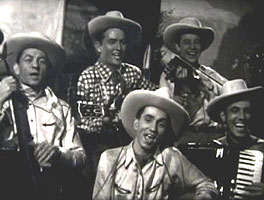 Singing cowboy film star Jimmy Wakely & His Band are pommelled into the "korn" category of hick/hillbilly soundies though given half a chance they'd be a serious western swing group.
Singing cowboy film star Jimmy Wakely & His Band are pommelled into the "korn" category of hick/hillbilly soundies though given half a chance they'd be a serious western swing group.
The soundies included a whole big sub-genre of korn, which relied on hillbilly stereotypes. When on the rarer occasions when a soundie featured an authentic western swing band or country singer, the city slickers who produced these things just couldn't help but frame the acts as korn.
For The Covered Wagon Rolled Right Along (1941), we get a wild west setting busied up with plenty of cast extras.
The song was by the musical comedy composers Hy Heath & Britt Wood. It's minor, but not a terrible piece of western swing, though pretty much the same tune as for "Coming Round the Mountain" hence massively unoriginal, besides rather offensive to Native America.
How it became so popularly recorded by so many artists is beyond me, except it's not always clear-cut where "korn" faux-hillbilly acts end & real cowboy musical comedy begins. So this song was covered by such diverse bands & singers as Tex Williams, Spade Cooley, Spike Jones' City Slickers, & Merle Travis.
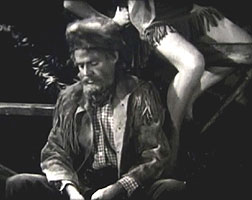 Jimmy Wakely & his boys appear in a load of B westerns, not the best of the genre but the singing's usually all right. And he might've come off better in The Covered Wagon Rolled Right Along if the director of the soundie hadn't had the rhymed story "re-enacted" on screen via abominable stereotypes of korn komedy. Jimmy Wakely & his boys appear in a load of B westerns, not the best of the genre but the singing's usually all right. And he might've come off better in The Covered Wagon Rolled Right Along if the director of the soundie hadn't had the rhymed story "re-enacted" on screen via abominable stereotypes of korn komedy.
The lyric runs in part: "We crossed the reservation of the Sioux/ While the Indians stood & watched us passing through/ Not a redskin dared to trifle/ While old pappy held his rifle/ And the covered wagon rolled right along."
A woman rides through the scene, we see pappy whittling in a coonskin cap, cowgirls in short skirts, & Jimmy's band in goofy wild west costumes.
Pappy, who is the primary "korn" stereotype of the production, asks one of the girls, "You wanna jitter, bug?" She giggles & tells him he's too old & should sit down & watch her do it alone. She then does a sexy shimmy/charleston as the band sings another cornball verse.
Pappy harrasses two more women until one of them agrees to dance with him, & they do okay with a ho-down jitterbug until pappy accidentally throws the girl on the ground. The visuals of this one are so lame that it's hard to care about the tune either, but it's certainly lively.
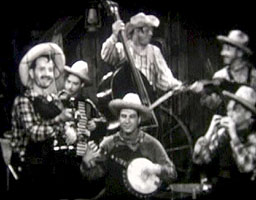 Frank Novak's Rootin' Tooters are a hillbilly act such as were a sub-specialty among the soundies. These were certainly not the kinds of short musical films that made the suondies so significant historically, certainly not for the music itself. But the "hick" novelty acts can be fun to see.
Frank Novak's Rootin' Tooters are a hillbilly act such as were a sub-specialty among the soundies. These were certainly not the kinds of short musical films that made the suondies so significant historically, certainly not for the music itself. But the "hick" novelty acts can be fun to see.
To me it's intriguing that such were once more than just a tad bit liked by people, for if they hadn't been, such acts wouldn't've proliferated as they did.
They're not to be confused with authentic mountain folk music of any kind, as the acts were mostly based on stereotypes of mountain people nowhere near the real thing, & rarely anywhere near the quality of country, bluegrass, or folk music.
And if you were part of rural America, seems like these stereotypes would be more insulting than amusing, so I can only imagine that urban teenagers unsophisticated in their funny-bone popped in dimes to see such stuff.
In Barn Dance Frolics (1941) we're introduced to square dancing gals who hop around in flouncy dresses with their hillbilly beaus. The Rootin' Tooters, six in number, play banjo, harmonica, slap bass, two fiddles, & an accordion. A scruffy hick fiddler sings the square dance tune: "Grab a gal away we go/ Keep on a movin' don't be slow..." nothing at all original about it.
The square dancers aren't bad if you like that sort of thing, & a very cute moment arises when three of Tooters (including that fiddler) play orcarinas together. Then four of the guys harmonize a bit on different song that might pass for okay bluegrass if they weren't camping it up so badly:
"Hand me down my walking cane/ Hand me down my walking cane/ Oh hand me down my walking cane, I'm gonna leave on a midnight train/ All my sins are taken away."
The versatile band returns to the square dance song with solo moments on sundry instruments, not always teh same instruments seen earlier. We're also shown a few lovely gals sitting in the straw, for gorgeous gals being de rigour for the soundies. It may not be great music, but for what it is, this one's played well, & every second of it is lively.
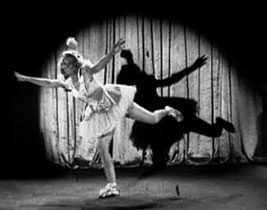 Another "korn" soundie features Cindy Walker as an Ella Mae type hillbilly gal, our titular Hillbilly Ballerina (1942). Cindy was a very capable singer but for some reason the soundies misused her as a novelty-number goofball, in the likes of Hillbilly Ballerina or Bearcat Mountain Gal (1942).
Another "korn" soundie features Cindy Walker as an Ella Mae type hillbilly gal, our titular Hillbilly Ballerina (1942). Cindy was a very capable singer but for some reason the soundies misused her as a novelty-number goofball, in the likes of Hillbilly Ballerina or Bearcat Mountain Gal (1942).
We first see our dubious ballerina with her aching feet in a tub of water, seated with her guitar, strumming & singing with an exaggerated hilljane accent.
The hokum lyrics are about her longing to be a ballerina. Even though no one besides herself thinks she can dance, she'll never again be content to just milk cows. "I went off to the city, to be a ballet queen/ Der der der der der dirdle-dirdle-dee, like the girl in the magazine..."
We're shown in flashbacks our hillbilly ballerina in dance school, a very horrible dancer though no worse than her teacher who is dressed up as some stereotype Frenchie. This teacher is at least partially a fraud who demands payment in advance, but does then make her his star pupil. At first he seems merely to be exploiting her for the fees, but as the soundie progresses, we're apparently supposed believe he has real faith in her growing ability.
The lyrics continue to tell us the story as we watch it acted out. On her graduation day she gets to have a dance recital at an opry house. On her way she stops into a sody fountain to have herself a sody, but is accidentally given liquor.
She gives a wondrously absurd drunkard's ballet, humiliating herself as well as her teacher, & losing what she imagined would've been her chance at fame. The "suprise ending" is she is now just a taxi-dancer earning ten cents a dance, thus her need to soak her aching feet, often stepped on by clumsily dancing sailors.
As novelty soundies go this one's cute, but the song is just so awful, & Cindy makes no effort to give any life as she drones through the lyrics. She's much, much better in other korn soundies & sometimes uplifts the dubious genre, but in this one you can almost tell she's wondering why in hell she even bothers.
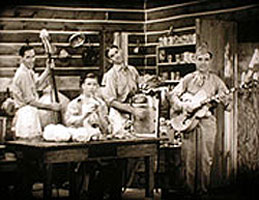 The Hoosier Hot Shots likewise practiced in that area of musical comedy called "Korn" which usually sucks, sucks, sucks. But they brought such fine musicianship to their antics that they inspired the more effective Spike Jones. The Hoosier Hot Shots likewise practiced in that area of musical comedy called "Korn" which usually sucks, sucks, sucks. But they brought such fine musicianship to their antics that they inspired the more effective Spike Jones.
They had a network radio show The National Barndance, originating at WLS in Chicago, very popular in their heyday. They had every claim to the name "hoosiers" as they were all Indianans.
The Hoosiers consist of washboard player Paul "Hezzie" Trietsch, guitarist Ken Trietsch, clarinetist Gabe Ward & Frank Kettering on bass. Their first soundie was K. P. Serenade (1942). They're shown doing kitchen duty at an army camp, skinning potatoes, doing dishes, & so on.
Three of the lads stand up to sing. "Now Jimmy Jones came here to camp/ And he walked with a military swing/ He said this here military life is great/ Except for just one thing..." They each take a verse naming the "one thing," Hezzie hates peeling potatos but peels & peels, Frank hates slicing tomatos but has to slice & slice, Gabe hates sweeping up but he'll sweep & sweep.
We haven't seen them with their instruments through all this, & Ken came & went on & off stage without singing with the other three. But finally Ken enters with his guitar & suddenly all the Hoosier Hot Shots all magically have their instruments.
The extended instrumental is pulled off much better than the song deserved, with the washboard & the clarinet the starring instruments. As korn goes, this is good stuff, she said with surprise.
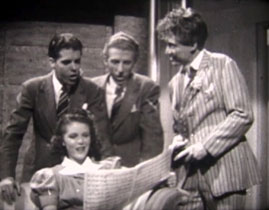 Lud Gluskin's & His Orchestra is heard but not seen in Elmer's Tune (1941), which opens with a hick (Redd Harper as Elmer) sitting on a fence with his penny whistle, indicating this soundie is going to be of the sub-genre called "korn" or faux hillbilly humor. It actually turns out to be much richer than korn ever gets to be.
Lud Gluskin's & His Orchestra is heard but not seen in Elmer's Tune (1941), which opens with a hick (Redd Harper as Elmer) sitting on a fence with his penny whistle, indicating this soundie is going to be of the sub-genre called "korn" or faux hillbilly humor. It actually turns out to be much richer than korn ever gets to be.
To the instrumentation we next see the hick Elmer in his farmhouse, under lamplight, writing music with a feather quill. Next thing you know, we see urbanites, the Dorn Brothers & Mary, singing the number as Redd hovers over them in his rumpled Sunday best.
A newspaper called the Hollywood Press fils the screen with the headline is "Everbody's Playing Elmer's Tune," an evident hit though hardly good enough to have been one.
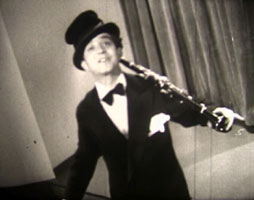 We then see a montage of performers who have covered the tune, lighting at last on comic singer & vocal impersonator Jackie Greene. We then see a montage of performers who have covered the tune, lighting at last on comic singer & vocal impersonator Jackie Greene.
Jackie first does an impersonation of Ted Lewis in top hat & with clarinet, working in his slogan "Is everybody happy!" It then cuts to Jackie in blackface impersonating Al Jolson singing "Elmer's Tune" working in "Mammy."
It then cuts to Jackie in straw hat with cane mimicking Harry Richmond. In his final impersonation he's sitting at a piano & has a putty nose extension to mimic Jimmy Durante, with "I got a million of em" worked into the hasty performance.
Returning to the Dorn Brothers & Mary to continue the song, filmed through a ship's wheel: "Every body 'neath the sun & the mono/ All sing Elmer's tune." Lastly we get to see "Elmer" living it up with a couple girlfriends.
The soundie is not bad, being more elaborate than usual makes it a fun film. "Elmer's Tune" was actually written by Elmer Albrecht, Sammy Gallop, & Dick Jurgens.
This became the title soundie for the compilaton The Swing Years: Elmer's Tune (2004), a random array of soundies including examples of korn, black-cast, classical adaptation, swing, crooner, "dancies," & patriotism, with a couple random clips thrown in without reference to source.
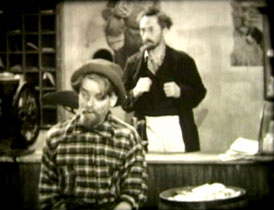 Dressed up like country bumpkins & gathered around the potbelly stove in the general store, a close-harmony singing group called The Jesters sings the hillbilly novlety tune The Martins & the Coys (1941) which starts out to the tune of "She'll Be Coming 'Round the Mountain When She Comes":
Dressed up like country bumpkins & gathered around the potbelly stove in the general store, a close-harmony singing group called The Jesters sings the hillbilly novlety tune The Martins & the Coys (1941) which starts out to the tune of "She'll Be Coming 'Round the Mountain When She Comes":
"Gather round good people & we'll tell a story/ Of the mountaisn in the days when guns was law/ When these families got to feudin'/ It was bound to end in shootin'/ So just listen & we'll tell you what we saw."
The Jesters had previously recorded this as a near-hit, along with another novelty tune "She Lived Next Door to the Firehouse." Both were afterward filmed as early soundies. Written by Alan Cameron and Ted Weems, "The Martins & the Coys" was initially recorded in 1936 by Ted Weems & His Orchestra, with vocalist Elmo Tanner. It was most famously sung by Gene Autrey with Smiley Burnette in one of Autrey's better films, The Big Show (1936).
With lovely lasses hanging around, & one misplaced little boy, The Jesters continue their ridiculous song: "Oh the Martins & the Coys/ They was reckless mountain boys/ And they took up family feudin' when they'd meet/ They would shoot each other quicker/ Than it took your eye to flicker/ They could knock a squirrel's eye out at ninety feet."
The sight gags are pretty lame. One hillbilly keeps stealing crackers from the shopkeeper's cracker barrel, so the shopkeeper puts a mouse trap in the barrel to snap onto the thief's fingers. That's as funny as it gets.
As the story of their mountain battles continues musically, the scene cuts to the otuside of a wooden shack, with an old hillbilly grampa drinking mountain dew from a jug, steeling eggs from the Martins' henhouse. A Martin, sitting in the outhouse with his rifle, shoots grampa through the outhouse air-hole, & that's how the feud began.
Feuding scenes follow, semi-humorous but not really. As the song is winding up, the lyrics reveal there was in the end only one Coy remaining, Henry Coy, & only one remaining Martin, a pretty gal named Grace. They were set on finishing the feud, but fell in love instead.
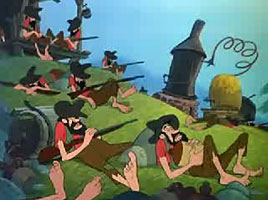 The soundie version of this song predated the Disney cartoon by five years, & Gene Autrey's version by a decade, but only a year after it was heard in the Roy Rogers film The Man from Oklahoma (1945).
The soundie version of this song predated the Disney cartoon by five years, & Gene Autrey's version by a decade, but only a year after it was heard in the Roy Rogers film The Man from Oklahoma (1945).
The Martins & the Coys (1946) features the King's Men's harmony quartet singing "the rustic ballad" on the sound track. The King's Men get their own credits card in the opening credits, on which they are drawn as four singing ears of corn, corn silk for their hair; a reference to the musical comedy genre called "korn."
This cartoon was first released as a set of ten musical cartoons under the collective title Make Mine Music (1946). By now the time seemed right for an outburst of White Pride, as the cartoon was heavily critcized for portraying mountain people as drunken, squallid, toothless, violent laughing killers. A review in The Nation by James Agee declared it "infinitely insulting."
Disney smarted from the public's disdain, & feels it even to this day. A new release of Make Mine Music on dvd includes only nine of the original ten cartoons, "The Martins & the Coys" being left in the vaults with a lot of warmongering or racist cartoons from the '30s & '40s. Disney should instead be embarrassed by corporate censorship.
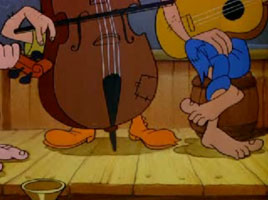 The criticisms of "korn" comedy musical acts had not been so widely heard before the war, but times were changing. That didn't stop the popularity, even in the face of criticism, of the Ma & Pa Kettle films, or Li'l Abner comic strip & animated cartoons, culminating in 1960s' television fare like The Beverly Hillbillies, Petticoat Junction, & Green Acres in 1960s television. The criticisms of "korn" comedy musical acts had not been so widely heard before the war, but times were changing. That didn't stop the popularity, even in the face of criticism, of the Ma & Pa Kettle films, or Li'l Abner comic strip & animated cartoons, culminating in 1960s' television fare like The Beverly Hillbillies, Petticoat Junction, & Green Acres in 1960s television.
The cartoon opens with hillbillies lazying all over a hillside after getting drunk on moonshline, then some more lazy hillbillies on the porch of a tumbledown cabin sleeping with a pig. Grampa Coy staggers drunkenly to the Maratins' cabin, then everyone on both sides of the crick become lively with gunplay.
A ghost sequence of slain hillbillies assumes that even killers get their angel wings & live thereafter in the clouds. Eventually as the lyric tells us "On each side they only had one person left."
These two continue hunting one another with rifles, but when they finally come face to face, love overcame 'em, even in spite of the winged spirits of dead Coys & Martins yelling iin the clouds, encouraging them to kill each other.
There's a ho-down square dance to celebrate the wedding, with a pair of square dance tunes replacing the comic ballad. The coda brings back an extra verse to the feud ballad, in which the last of the Martins & the Coys, Grace & Henry, fight like cats & dogs every day, thus "they carry on the feud just like before."
copyright © by Paghat the Ratgirl
|
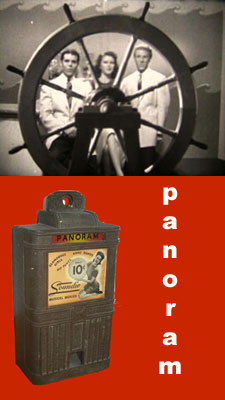

 Jimmy Wakely & his boys appear in a load of B westerns, not the best of the genre but the singing's usually all right. And he might've come off better in The Covered Wagon Rolled Right Along if the director of the soundie hadn't had the rhymed story "re-enacted" on screen via abominable stereotypes of korn komedy.
Jimmy Wakely & his boys appear in a load of B westerns, not the best of the genre but the singing's usually all right. And he might've come off better in The Covered Wagon Rolled Right Along if the director of the soundie hadn't had the rhymed story "re-enacted" on screen via abominable stereotypes of korn komedy.



 We then see a montage of performers who have covered the tune, lighting at last on comic singer & vocal impersonator Jackie Greene.
We then see a montage of performers who have covered the tune, lighting at last on comic singer & vocal impersonator Jackie Greene.

 The criticisms of "korn" comedy musical acts had not been so widely heard before the war, but times were changing. That didn't stop the popularity, even in the face of criticism, of the Ma & Pa Kettle films, or Li'l Abner comic strip & animated cartoons, culminating in 1960s' television fare like The Beverly Hillbillies, Petticoat Junction, & Green Acres in 1960s television.
The criticisms of "korn" comedy musical acts had not been so widely heard before the war, but times were changing. That didn't stop the popularity, even in the face of criticism, of the Ma & Pa Kettle films, or Li'l Abner comic strip & animated cartoons, culminating in 1960s' television fare like The Beverly Hillbillies, Petticoat Junction, & Green Acres in 1960s television.